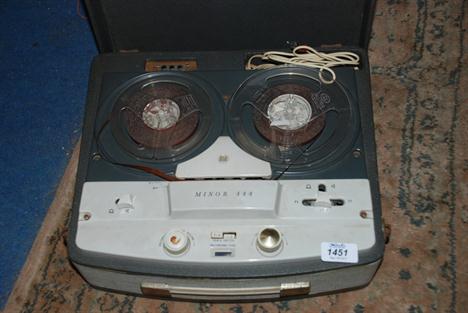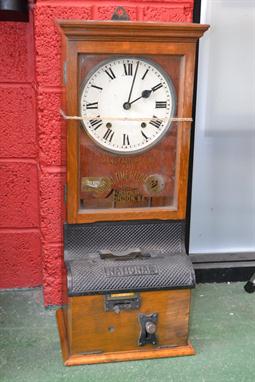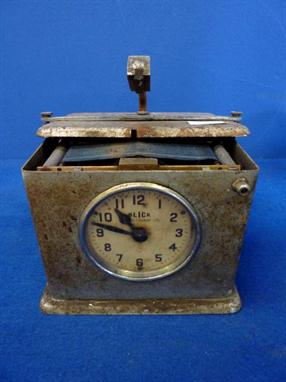Jadwiga Lesiecka, Polish b.1921- Girl playing the recorder to birds; oil on board, signed, inscribed `Paris` and dated `58, 25x16.7cm: together with another oil on board by the same artist, depicting a man playing the cello, signed and dated `58, 28.5x9.2cm, (2), (may be subject to Droit de Suite)
10165 Preisdatenbank Los(e) gefunden, die Ihrer Suche entsprechen
10165 Lose gefunden, die zu Ihrer Suche passen. Abonnieren Sie die Preisdatenbank, um sofortigen Zugriff auf alle Dienstleistungen der Preisdatenbank zu haben.
Preisdatenbank abonnieren- Liste
- Galerie
-
10165 Los(e)/Seite
A Walkers heavy brass “Trident” ship log recorder head, together with spinner, wheel, brass connector, and a length of cord; also a ship’s overhead mounted brass compass, 6” diameter, mounted on gimbals, by Summers & Payne, Southampton; a good quality 19th century lacquered brass table telescope stand, with clamp for 1-5/8” diameter tube and folding tripod legs, height 13½”; and 4 old butcher’s meat cleavers with turned wood handles. Average GC
Séamus Ó Colmáin (1925-1990) STREET SCENE, 1964oil on boardsigned lower left; inscribed [Feb] and dated on reverseL36 by 48in., 90 by 120cm.Purchased in a Dublin gallery by the present owner`s family;Thence by descent to the present owner;Private Collection, EnglandPossibly exhibited at `Tenth Anniversary Exhibition`, Ritchie Hendriks Gallery, Dublin, September - October 1966, catalogue no. 21Thought to be a Dublin scene.In his article for the Irish Times 6 July 1970, Brian Fallon drew comparisons between Ó Colmáin and another famed recorder of the Dublin Streets, Harry Kernoff - `The parallel with Kernoff is fruitful, because Kernoff`s best works - apart from his woodcuts - are his early pictures of his native city, in which one can almost hear the Dublin accent. The same is true of Ó Colmáin, who has painted its crumbling façades with a likeable near-sentimentality and at times a real painterliness.`
Derek Clarke RWS RSA (b.1912) Connemara Family Oil on canvas, 91.5 x 122cm (36 x 48") Signed and dated 1946 Exhibited: The Royal Hibernian Academy, London 1947, Cat. No. 335; The Royal Scottish Academy 1948; "Derek Clarke - Paintings and Drawings in Connemara 1938, 1939, 1946" Exhibition, The Frederick Gallery, September 2004, Cat. No. 41, where purchased by current owner Derek Clarke wrote for the Frederick Gallery about his time in Ireland and how this painting came about: "I am one of those artists who, having completed their Art School training by 1935, only had four years in which to establish themselves before war put an end to their careers - in many cases forever. In those days there were few travelling scholarships bursaries or prizes: those who could went off to Paris to further their development. My main influences were Cézanne and Van Gough, but I had no desire to be an adherent of any art movement. Instead I wished to find out whether I had a voice of my own. In 1937 I was in Ireland, carrying out commission portraits in Co. Tipperary and Co. Donegal. My patrons suggested that the place I was seeking might very well be Connemara, and a visit was arranged. The following year I set off on my bike across Ireland, travelling over the Burren to Galway, then along the coast road until I came across the village where the greatest number of red petticoats could be seen among the white or blue-washed houses, Rossaveel. Surely this must be the heart and centre of the Gaeltacht! The lodgings in which I settled provided a room in which to paint, but I was deprived of this facility on the arrival of a young man, Brian MacLochlainn, sent by the Irish Folklore Commission to discover whether there were any seanachaÃs (Gaelic storytellers) still in the district. He was a great help to me. I accompanied him on his evening sessions, equipped with his clockwork waxed drum recorder. Next day he would write the stories out in longhand, explaining obscure passages and obsolete words. He suggested that I would be considered very stand-offish if I went knocking on people's doors. So this set a pattern of my visiting. I would enter their houses, out would come The Chair and be dusted for me; I would decline and sit on the bench or stool. There ensued lengthy apologies that I regretted I had no Irish, and that they had no English. None of the children had any English, but usually some older person could speak it, having returned from America to get married or to claim some property. Then I would ask them whether I might make a drawing of them or their children. Apart from the women's paisley shawls, all clothes were made in the village; wool was carded and spun in the cottages, woven by the village weaver into all-purpose cloth, and made into clothes by the village tailor. All the young children wore the petticoat and had cropped heads with a small fringe or forelock. I was given to understand that the inability to tell the difference between the girls and the boys was to safeguard against losing the boys for changelings. When the children first went to school the mother was given 'the boot money', but the children continued to pad to school on their beautifully shaped feet. The older boys wore knickerbocker suits, and the older lads, like the men folk, wore the banÃn, a coat without lapels or buttons, made from white wool. After Christmas I moved to nearby Carraroe, where I was given a large white-washed bedroom and my own turf fire. So at last I had the facilities to do more painting. Unfortunately war was declared in September of that year. Having been wounded in Tunisia during the war, I was fortunate to be given a whole year's sick leave, which gave me the opportunity to do some painting based on my Connemara experience. In 1946 I returned to Carraroe with my wife, and was given the same large whitewashed room. To start painting again from scratch was like starting a new life. Post-impressionism was now history, American and International Art has not yet taken over. Some artists turned to abstraction, others to surrealism. Others, like me, felt the need to go back to nature and start learning again. One hot Sunday afternoon, I was painting a watercolour and ran out of water. I went into the nearest house to ask for more. The whole family stood around the fireplace, staring at me exactly as for the desired painting; the composition was already completely determined for the painting 'Connemara Family'. Father was at home dandling the baby. Mother was baking the daily loaf of soda bread in the pot oven. Best of all, they agreed to let me paint them in their house, and to pose for me whenever I wanted. I could not possibly have carried this out, if it had not been for the kindness of a young couple who lived a hundred yards down the road, and allowed me to leave the painting overnight, or contemplate it, or work on it on stormy days. My canvas and the sitters were lit by the window on the left, and the door open on the right. This interest in a double source of light is an important feature of this painting, and has stayed with me in all my paintings of people. When painting this picture, I usually started by asking two of them to pose together, before concentrating on one. I kept a strict record of the number of hours that each posed for me. The eldest girl (on the far right) worked in a knitting 'factory' which employed a few girls, learning to knit jerseys in imitation of the ingenious Aran Island patterns. Her sister wears a dress sent by her cousin in America. The little boy in the foreground wears the petticoat. Those worn by the two sisters in the centre had been improved by their mother, who added collars and dyed them blue. The elder of the two had the reddest hair that I have ever seen, yet as dark as the sooty fireplace behind her. The image of the Sacred Hear above the mantelpiece, which was a feature of every house, was the apex of the composition. Thanks to their co-operation I was able to complete this painting in circumstances which I doubt if another artist has experienced."
Quantity of Subbuteo accessories, includes: 2 x C142 Terrace Set; C118 European Competitions Cup; C120 Footballer Statuette; TC-G Cricket Bat with Handle (bagged); 2 x C115 Match Score Recorder; C143 Corner Terrace Unit; 2 x Floodlights. Boxed. Together with a quantity of unboxed items including C140 Stadium, and loose players.
A GENTLEMAN`S STAINLESS STEEL GALLET YACHTING CHRONOGRAPH WRISTWATCH, CIRCA 1960s, D: Silver dial with Arabic numerals, double register recording continuous seconds & a count down minute recorder. M: Valjoux 7730 movement signed Gallet & Co. C: Circular case signed Gallet & Co, case diameter approx 36mm. S: Black perforated racing strap. CONDITION REPORT D: Original dial in excellent condition. M: In working order at present. C: In excellent condition. S: In very good condition. D: Dial / M: Movement / C: Case / S: Strap / B: Bracelet.
A GENTLEMAN`S NICKEL AND STEEL CASED GALLET CHRONOGRAPH WRISTWATCH, CIRCA 1940s, D: Silver dial with Arabic numerals, up & down double register, continues seconds & minute recorder. M: 17 jewel manual wind Venus chronograph movement signed Gallet & Co. C: Circular case signed Gallet & Co, case diameter approx 32mm. S: Brown strap. CONDITION REPORT D: Original dial in very good condition, slight discolouration. M: In working order at present. C: In good condition, some wear to the case middle and pushers. S: In very good condition. D: Dial / M: Movement / C: Case / S: Strap / B: Bracelet.
Follower of George Henry Harlow (British, 1787-1819), Portrait of James Losh, Recorder of Newcastle on Tyne, (1763-1833). oil on canvas, 74 x 62cm (29 x 24in). James Losh was from a landed Cumberland family and was the first Chairman of the Newcastle-Carlisle railway. He was a barrister and politician, reformer, health campaigner and fought against slavery and child labour He was later a Court Recorder. His daughter, Cecilia Losh, married William Gale
Bindings. Poetry of the Anti-Jacobin, by Alexander Watson, 4th ed., 1801, a.e.g., contemp. gilt dec. green morocco by Hering, gilt armorial of Henry Welbore Agar-Ellis, 2nd Viscount Clifden (1761 -1836) to centre of each board, joints rubbed, 4to, together with Lamia’s Winter-Quarters, pub. Adam & Charles Black, 1907, col. plts. and b & w illusts., t.e.g., elaborate gilt dec. morocco to endpaper pastedowns with silk lined free endpapers, elaborate gilt dec. morocco, slightly rubbed to joints, 4to, (limited signed edition 47/250), with C. Crispi Sallustii Opera quae Exstant..., pub. Basil Montagu Pickering, 1864, armorial bookplate of James W. Arbuthnot to upper pastedown, near contemp. morocco gilt by B.M Pickering, gilt foliage wreath device to centre of each board, spine slightly faded, 4to, plus The Book of Common Prayer..., pub. William Pickering, 1844, dec. title, dec. initials, text in red & black, silk endpapers, gilt dec. dentelles, a.e.g. with gauffered edges, contemp. gilt dec. spine, extrems. rubbed, folio. Henry Welbore Agar was the eldest son of James, 1st Viscount Clifden, of Gowran Castle, County Kilkenny, and Lucia, eldest daughter of John Martin, of Dublin. He was educated at Westminster School, and admitted to Christ Church, Oxford. He was Member of Parliament for Kilkenny in the Irish Parliament 1800-1802, and for Heytesbury in the Union Parliament, Clerk of the Privy Council of Ireland and Recorder of Gowran. He also commanded a troop of cavalry known as the Gloucester Troop, drawn chiefly from his own tenants. He married Caroline Spencer, daughter of George, 4th Duke of Marlborough in 1792. He succeeded his father as 2nd Viscount Clifden in 1789, and assumed the additional name and arms of Ellis in 1802 on inheriting the Barony of Mendip from his uncle, Welbore Ellis. (4).
-
10165 Los(e)/Seite



![Séamus Ó Colmáin (1925-1990) STREET SCENE, 1964oil on boardsigned lower left; inscribed [Feb] and dated on reverseL36 by 48i](http://lot-images.atgmedia.com/SR/10092/2876358/6-201357152737_468x382.jpg)










![A Lockheed `U.S. Navy Buweps` [Bureau of Naval Weapons] recorder for measuring and recording temperature etc. on Partlow Co](http://lot-images.atgmedia.com/SR/36301/2875920/207-20135111129_468x382.jpg)



































